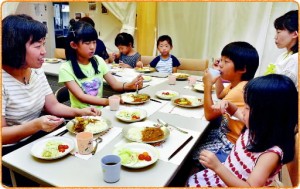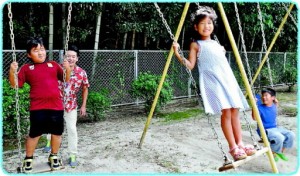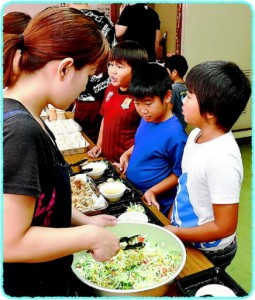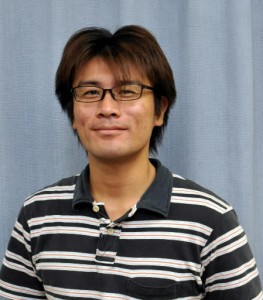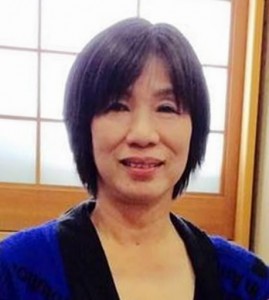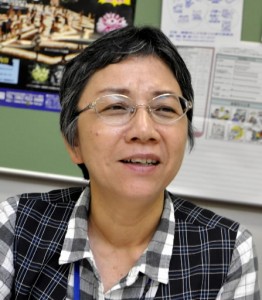Peace Seeds: Teens in Hiroshima Sow Seeds of Peace (Part 36)
Sep. 15, 2016
The “kodomo shokudo cafeteria,” a place to aid children with hot meals and warm support
Have you ever heard of the “kodomo shokudo cafeteria,” a soup kitchen for children? It’s a place that provides hot meals and a relaxing space for free or at a low cost to elementary school and junior high school students and their family members. An increasing number of these cafeterias have opened recently in the Chugoku region of western Japan. The staff at these facilities are seeking to create a space where all are welcomed with a smile and the words “Welcome home!”
Poverty in families underlies the rise of such cafeterias in Japan. Even when children appear to be happy and smiling, they may be troubled by deep worry. This is why it’s vital for the people around them to be aware of their concerns and lend support, as needed, on a daily basis.
In the past, many children led difficult lives because of the war and the atomic bombing. We should never make children suffer such an experiences again. Why not stop by a kodomo shokudo cafeteria, eat a meal with some children, and look for ways you might help, too?
Hiroshima YWCA (Young Women’s Christian Association) provides a cozy space with cheerful conversation
As the visitors eat curry rice, with summer vegetables, in a cozy atmosphere, an adult asks a child such questions as “Is the curry rice good?” and “What do you do after school?” They are seated at the cafeteria run by the Hiroshima YWCA (Young Women’s Christian Association) at the Hiroshima Shujo Church in Higashi Ward since July. Under the name “Curry Party,” it is open every fourth Tuesday of the month from 5:30 to 7:30 p.m.
The curry prepared that day includes donated pumpkins and pork that was supplied by a local butcher at a discounted price. After the ingredients in the curry are explained, the 10 children and 27 adults, who are YWCA members and local residents, eat their meals together. Those who finish eating early then help clear the table. Afterward, the children play together with a shooting game or by making a spinning top.
The Hiroshima YWCA is also planning to support children in their learning. Fuko Nakaki, 35, the director of the group, said with enthusiasm, “I want to build relationships that will enable both parents and their children to rely on us. I’d like to make this cafeteria an even more appealing place so that more people will come to know about it.”
Anyone can join the “Curry Party” for curry and rice. The cost is 100 yen for children aged 18 or younger, and 300 yen those over the age of 19. Saya Tanabe, a sixth grader at Inokuchidai Elementary School and a resident of Nishi Ward, enjoyed her experience there, saying, “I was able to have dinner and talk with people that I hadn’t met before. I’d like to come here again.”
For inquiries, please contact the Hiroshima YWCA at 082-258-4878 (available from 10 a.m. to 4 p.m. on Wednesday, Thursday, and Friday).
(Written by Hiromi Ueoka, 15)
Toride in Iwakuni offers an inviting place for both children and parents
Toride, a non-profit organization in Iwakuni, Yamaguchi Prefecture, organizes a kodomo shokudo cafeteria twice a month on Saturday, from 11 a.m. to 2 p.m., at the Hirata Kyoyo Kaikan located in Hirata 3-chome, Iwakuni. Normally, there is no school lunch when schools have classes on Saturday. On the day we went there, the menu was fried chicken, salad, brown rice balls, and vegetable soup. About 20 adults and children prepared the meal and ate it together.
As the children asked for more helpings, the mound of fried chicken quickly disappeared. After eating lunch, the children enjoyed some free time and played games in the room or played at the neighboring park. Shukan Kanemoto, 33, the director of the organization, said, “I want to create a place where children can act on their own initiative. I hope their parents will come, too, and feel relaxed here.”
When Mr. Kanemoto worked at a children’s shelter in the past, he thought about ways to address family issues earlier in their lives as families. Toward this end, in June he launched the cafeteria. His organization also lends additional support to those who are having difficulty making a living. He told us that he hopes to hire dedicated staff to run the cafeteria and hold it more frequently and at more venues.
Children of junior high school age and younger can take part for free, while high school students and adults must pay 500 yen. A single mother, 44, who came to the cafeteria with her daughter, a 6-year-old first-grader, said, “My daughter was looked after by many people and she enjoyed playing to her heart’s content. Thanks to this cafeteria, we now also have more opportunities to cook meals together at home. Because single parents tend to be isolated in the community, it’s very helpful for me to have a place like this where I can receive support from others.”
For inquiries, please contact Toride at 0827-35-6509.
(Written by Shunichi Kamichoja, 16)
Other “Kodomo shokudo cafeterias” in Hiroshima
Christian Community Service Agency
Address: 1-13-3, Ogawachi-cho, Nishi Ward
Telephone: 082-232-4274
Schedule and Participation Fee:
- Open from 7 p.m. to 9 p.m. on second and fourth Fridays of the month
- Free of charge for children of junior high school age and younger, 300 yen for high school students, 200 yen for adults
Message from Yuki Suma, head of the group
We prepare homemade meals that are more difficult to make, things that can’t be cooked at home because people don’t have the time, as well as meals that are popular with children. We are happy to welcome you with a hot meal. (Written by Atsuhito Ito, 13)
Aozora Youth Activity Support Center
Address: 4-10-8-201, Kabe, Asakita Ward
Telephone: 082-562-2451
Schedule and Participation Fee:
- Open twice a month from 6 p.m. to 7 p.m. in a time slot for Mochinoki, a free study space which is open every Thursday.
- Open for elementary school students, from the third to the sixth grade, who are participating in the free study space. The fee is 100 yen per person.
Message from Ikuko Masutani, co-leader of the center
Though it isn’t fancy, we offer hot homemade meals and good company. Whether or not you face financial difficulties, you are welcome to join us if you don’t want to eat dinner alone. (Written by Hiromi Kamioka, 15)
Interview with Chikako Suzukawa, manager of the Welfare Division, Hiroshima City Council of Social Welfare
What role does the kodomo shokudo cafeteria play and what challenges does it face? Junior writers from the Chugoku Shimbun interviewed Chikako Suzukawa, 59, the manager of the Welfare Division of the Hiroshima City Council of Social Welfare, located in Naka Ward.
Why are these cafeterias needed?
Around ten years ago, an increasing number of people began working in unstable employment conditions, such as temporary workers and part-time workers. Consequently, the number of households with less income and more difficult lives, compared to the past, is on the rise.
Moreover, there are now more single-parent households, too, which means that busy parents don’t have time to cook or that children must eat their meals alone. Less and less time is spent on communication within the family.
Children are suffering from poverty, in some cases both economically and mentally. But it can be difficult to identify this suffering because of the relative abundance of our society. As a result, some of these children become isolated. And some commit delinquent acts, such as shoplifting.
There are adults in local communities, though, that are creating places where they can interact with such children by offering meals. They also seek to build trusting relationships with the children by playing with them or helping them with their studies. In this way, adults can lend support, individually, to the children’s lives.
What must be kept in mind when running a cafeteria like this?
We have to be very careful about maintaining clean conditions. If one cafeteria causes a case of food poisoning, there’s the possibility that all of them would have to stop serving food. In addition, it’s important that the cafeterias keep a regular schedule. It wouldn’t be good for the schedule to change based on the convenience of the operator.
What makes an ideal kodomo shokudo cafeteria?
The cafeterias must be places where anyone can casually drop by. When that’s the case, then there won’t be any sense of discrimination over the fact that children coming to these cafeterias are from poor families. They should also be places where children can freely share their troubles with adults who are neither their parents nor their teachers. Building a so-called “diagonal relationship” with children, and creating a homelike atmosphere, is desired.
(Written by Riho Kito, 15)
Junior writers’ impressions
When I interviewed Ms. Suzukawa from the Hiroshima City Council of Social Welfare, she asked me, “What would you do if you learned that your classmate was going to a kodomo shokudo cafeteria?” I was surprised by the question and couldn’t answer right away. But through the interview, I came to understand that the kodomo shokudo cafeteria is a place where people from the local community can all come together and share a meal. So I finally answered the question by saying, “I hope the kodomo shokudo cafeteria is a place where everyone is welcome, as a matter of course.” I imagine it takes time for these cafeterias to take root within the community, but hopefully they can help reduce the number of people who feel isolated. (Hiromi Ueoka)
The experience I had writing this article was very special. Until I took part in the meeting to determine a topic for the article, I didn’t know anything about children living in poverty or the kodomo shokudo cafeteria. For the interview, I went to the cafeteria operated by Toride, an NPO in Iwakuni. I watched elementary school children playing together nicely, eating lunch, then going outside afterward to again play cheerfully. The children were so innocent, so I felt bad for them, but they all seemed to be enjoying the experience a lot. If I have the chance, I’d like to take part in another kodomo shokudo cafeteria. I’d like to play together with the children then. Reporting on this has made me keenly aware of the proverb that goes: “To see is to believe.” Though it was just a first step, I was able to gain some understanding of the field of social welfare services, which I knew nothing about. Moving forward, I want to treasure the things I saw and heard first-hand. (Shunichi Kamichoja)
The kodomo shokudo cafeteria was a more homey place than I had expected. I was surprised to learn that the staff members are, above all, thinking about the welfare of the children who are coming to the cafeteria and making various efforts to help them. I realized that’s why these cafeterias can become precious places for children. (Riho Kito)
When I went to the kodomo shokudo cafeteria at the Hiroshima YWCA, I tried to ask the elementary school children their impressions of the place, but it was difficult for me to get responses from them as I couldn’t properly ask questions. I was at a loss. Our interviews more often involve adults than children, so I’m not used to talking with children to gather information. I found that questions must be asked in a different way when the age of the person you’re interviewing is different. (Atsuhito Ito)
What is Peace Seeds?
Peace Seeds are the seeds of smiles which can be spread around the world by thinking about peace and the preciousness of life from various viewpoints. To fill this world with flowering smiles, 39 junior writers from the first year to the sixth year of high school, choose themes, gather information, and write articles.
(Originally published on September 15, 2016)
Have you ever heard of the “kodomo shokudo cafeteria,” a soup kitchen for children? It’s a place that provides hot meals and a relaxing space for free or at a low cost to elementary school and junior high school students and their family members. An increasing number of these cafeterias have opened recently in the Chugoku region of western Japan. The staff at these facilities are seeking to create a space where all are welcomed with a smile and the words “Welcome home!”
Poverty in families underlies the rise of such cafeterias in Japan. Even when children appear to be happy and smiling, they may be troubled by deep worry. This is why it’s vital for the people around them to be aware of their concerns and lend support, as needed, on a daily basis.
In the past, many children led difficult lives because of the war and the atomic bombing. We should never make children suffer such an experiences again. Why not stop by a kodomo shokudo cafeteria, eat a meal with some children, and look for ways you might help, too?
Hiroshima YWCA (Young Women’s Christian Association) provides a cozy space with cheerful conversation
As the visitors eat curry rice, with summer vegetables, in a cozy atmosphere, an adult asks a child such questions as “Is the curry rice good?” and “What do you do after school?” They are seated at the cafeteria run by the Hiroshima YWCA (Young Women’s Christian Association) at the Hiroshima Shujo Church in Higashi Ward since July. Under the name “Curry Party,” it is open every fourth Tuesday of the month from 5:30 to 7:30 p.m.
The curry prepared that day includes donated pumpkins and pork that was supplied by a local butcher at a discounted price. After the ingredients in the curry are explained, the 10 children and 27 adults, who are YWCA members and local residents, eat their meals together. Those who finish eating early then help clear the table. Afterward, the children play together with a shooting game or by making a spinning top.
The Hiroshima YWCA is also planning to support children in their learning. Fuko Nakaki, 35, the director of the group, said with enthusiasm, “I want to build relationships that will enable both parents and their children to rely on us. I’d like to make this cafeteria an even more appealing place so that more people will come to know about it.”
Anyone can join the “Curry Party” for curry and rice. The cost is 100 yen for children aged 18 or younger, and 300 yen those over the age of 19. Saya Tanabe, a sixth grader at Inokuchidai Elementary School and a resident of Nishi Ward, enjoyed her experience there, saying, “I was able to have dinner and talk with people that I hadn’t met before. I’d like to come here again.”
For inquiries, please contact the Hiroshima YWCA at 082-258-4878 (available from 10 a.m. to 4 p.m. on Wednesday, Thursday, and Friday).
(Written by Hiromi Ueoka, 15)
Toride in Iwakuni offers an inviting place for both children and parents
Toride, a non-profit organization in Iwakuni, Yamaguchi Prefecture, organizes a kodomo shokudo cafeteria twice a month on Saturday, from 11 a.m. to 2 p.m., at the Hirata Kyoyo Kaikan located in Hirata 3-chome, Iwakuni. Normally, there is no school lunch when schools have classes on Saturday. On the day we went there, the menu was fried chicken, salad, brown rice balls, and vegetable soup. About 20 adults and children prepared the meal and ate it together.
As the children asked for more helpings, the mound of fried chicken quickly disappeared. After eating lunch, the children enjoyed some free time and played games in the room or played at the neighboring park. Shukan Kanemoto, 33, the director of the organization, said, “I want to create a place where children can act on their own initiative. I hope their parents will come, too, and feel relaxed here.”
When Mr. Kanemoto worked at a children’s shelter in the past, he thought about ways to address family issues earlier in their lives as families. Toward this end, in June he launched the cafeteria. His organization also lends additional support to those who are having difficulty making a living. He told us that he hopes to hire dedicated staff to run the cafeteria and hold it more frequently and at more venues.
Children of junior high school age and younger can take part for free, while high school students and adults must pay 500 yen. A single mother, 44, who came to the cafeteria with her daughter, a 6-year-old first-grader, said, “My daughter was looked after by many people and she enjoyed playing to her heart’s content. Thanks to this cafeteria, we now also have more opportunities to cook meals together at home. Because single parents tend to be isolated in the community, it’s very helpful for me to have a place like this where I can receive support from others.”
For inquiries, please contact Toride at 0827-35-6509.
(Written by Shunichi Kamichoja, 16)
Other “Kodomo shokudo cafeterias” in Hiroshima
Christian Community Service Agency
Address: 1-13-3, Ogawachi-cho, Nishi Ward
Telephone: 082-232-4274
Schedule and Participation Fee:
- Open from 7 p.m. to 9 p.m. on second and fourth Fridays of the month
- Free of charge for children of junior high school age and younger, 300 yen for high school students, 200 yen for adults
Message from Yuki Suma, head of the group
We prepare homemade meals that are more difficult to make, things that can’t be cooked at home because people don’t have the time, as well as meals that are popular with children. We are happy to welcome you with a hot meal. (Written by Atsuhito Ito, 13)
Aozora Youth Activity Support Center
Address: 4-10-8-201, Kabe, Asakita Ward
Telephone: 082-562-2451
Schedule and Participation Fee:
- Open twice a month from 6 p.m. to 7 p.m. in a time slot for Mochinoki, a free study space which is open every Thursday.
- Open for elementary school students, from the third to the sixth grade, who are participating in the free study space. The fee is 100 yen per person.
Message from Ikuko Masutani, co-leader of the center
Though it isn’t fancy, we offer hot homemade meals and good company. Whether or not you face financial difficulties, you are welcome to join us if you don’t want to eat dinner alone. (Written by Hiromi Kamioka, 15)
Interview with Chikako Suzukawa, manager of the Welfare Division, Hiroshima City Council of Social Welfare
What role does the kodomo shokudo cafeteria play and what challenges does it face? Junior writers from the Chugoku Shimbun interviewed Chikako Suzukawa, 59, the manager of the Welfare Division of the Hiroshima City Council of Social Welfare, located in Naka Ward.
Why are these cafeterias needed?
Around ten years ago, an increasing number of people began working in unstable employment conditions, such as temporary workers and part-time workers. Consequently, the number of households with less income and more difficult lives, compared to the past, is on the rise.
Moreover, there are now more single-parent households, too, which means that busy parents don’t have time to cook or that children must eat their meals alone. Less and less time is spent on communication within the family.
Children are suffering from poverty, in some cases both economically and mentally. But it can be difficult to identify this suffering because of the relative abundance of our society. As a result, some of these children become isolated. And some commit delinquent acts, such as shoplifting.
There are adults in local communities, though, that are creating places where they can interact with such children by offering meals. They also seek to build trusting relationships with the children by playing with them or helping them with their studies. In this way, adults can lend support, individually, to the children’s lives.
What must be kept in mind when running a cafeteria like this?
We have to be very careful about maintaining clean conditions. If one cafeteria causes a case of food poisoning, there’s the possibility that all of them would have to stop serving food. In addition, it’s important that the cafeterias keep a regular schedule. It wouldn’t be good for the schedule to change based on the convenience of the operator.
What makes an ideal kodomo shokudo cafeteria?
The cafeterias must be places where anyone can casually drop by. When that’s the case, then there won’t be any sense of discrimination over the fact that children coming to these cafeterias are from poor families. They should also be places where children can freely share their troubles with adults who are neither their parents nor their teachers. Building a so-called “diagonal relationship” with children, and creating a homelike atmosphere, is desired.
(Written by Riho Kito, 15)
Junior writers’ impressions
When I interviewed Ms. Suzukawa from the Hiroshima City Council of Social Welfare, she asked me, “What would you do if you learned that your classmate was going to a kodomo shokudo cafeteria?” I was surprised by the question and couldn’t answer right away. But through the interview, I came to understand that the kodomo shokudo cafeteria is a place where people from the local community can all come together and share a meal. So I finally answered the question by saying, “I hope the kodomo shokudo cafeteria is a place where everyone is welcome, as a matter of course.” I imagine it takes time for these cafeterias to take root within the community, but hopefully they can help reduce the number of people who feel isolated. (Hiromi Ueoka)
The experience I had writing this article was very special. Until I took part in the meeting to determine a topic for the article, I didn’t know anything about children living in poverty or the kodomo shokudo cafeteria. For the interview, I went to the cafeteria operated by Toride, an NPO in Iwakuni. I watched elementary school children playing together nicely, eating lunch, then going outside afterward to again play cheerfully. The children were so innocent, so I felt bad for them, but they all seemed to be enjoying the experience a lot. If I have the chance, I’d like to take part in another kodomo shokudo cafeteria. I’d like to play together with the children then. Reporting on this has made me keenly aware of the proverb that goes: “To see is to believe.” Though it was just a first step, I was able to gain some understanding of the field of social welfare services, which I knew nothing about. Moving forward, I want to treasure the things I saw and heard first-hand. (Shunichi Kamichoja)
The kodomo shokudo cafeteria was a more homey place than I had expected. I was surprised to learn that the staff members are, above all, thinking about the welfare of the children who are coming to the cafeteria and making various efforts to help them. I realized that’s why these cafeterias can become precious places for children. (Riho Kito)
When I went to the kodomo shokudo cafeteria at the Hiroshima YWCA, I tried to ask the elementary school children their impressions of the place, but it was difficult for me to get responses from them as I couldn’t properly ask questions. I was at a loss. Our interviews more often involve adults than children, so I’m not used to talking with children to gather information. I found that questions must be asked in a different way when the age of the person you’re interviewing is different. (Atsuhito Ito)
What is Peace Seeds?
Peace Seeds are the seeds of smiles which can be spread around the world by thinking about peace and the preciousness of life from various viewpoints. To fill this world with flowering smiles, 39 junior writers from the first year to the sixth year of high school, choose themes, gather information, and write articles.
(Originally published on September 15, 2016)

